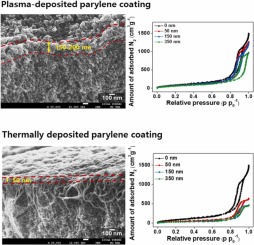- 제목
- [2023] [변재철] Parylene-coated SiO2 aerogel with controlled thermal conductivity
- 작성일
- 2024.03.19
- 작성자
- 에어로겔소재연구센터 관리자
- 게시글 내용
-
Parylene-coated SiO2 aerogel with controlled thermal conductivity
Abstract
The thermal properties of two types of SiO2 aerogels (waterglass and tetraethylorthosilicate (TEOS)) were investigated before and after parylene (parylene-N) coating using thermal deposition and plasma deposition methods. The surface morphology and the pore structure of the aerogels was analyzed using scanning electron microscopy and Brunauer–Emmett–Teller (BET) analyzer. After thermal deposition of parylene coating, the specific surface area of SiO2 aerogel was decreased to be –69.3% (for waterglass-based one) and –93.1% (for TEOS-based one). In the case of plasma deposition of parylene coating, the specific surface area of SiO2 aerogel was decreased only –21.9% (for waterglass-based one) and –16.8% (for TEOS-based one). The influence of the plasma-deposited parylene coating on the thermal conductivity was investigated by calculating the thermal conductivity from differential scanning calorimetry (DSC) analysis. After parylene coating by plasma-deposition, the thermal conductivity was decreased from 0.016 ± 0.001 W/m·K to 0.009 ± 0.001 W/m·K (from 0.035 ± 0.004 W/m·K to 0.025 ± 0.002 W/m·K) for TEOS-based (waterglass-based) SiO2 aerogel with the parylene coating thickness of 0–195 nm (0–181 nm), which represented the improved thermal insulating property after parylene coating. In the case of thermal deposition of parylene coating, the thermal conductivity was observed to change in the reversed-direction. The thermal properties of the two types of SiO2 aerogels were strongly influenced by the deposition methods of parylene. These results demonstrate that the parylene in different deposition methods could be effectively used to control the thermal conductivity of SiO2 aerogels synthesized from waterglass as well as TEOS.




